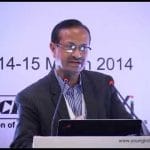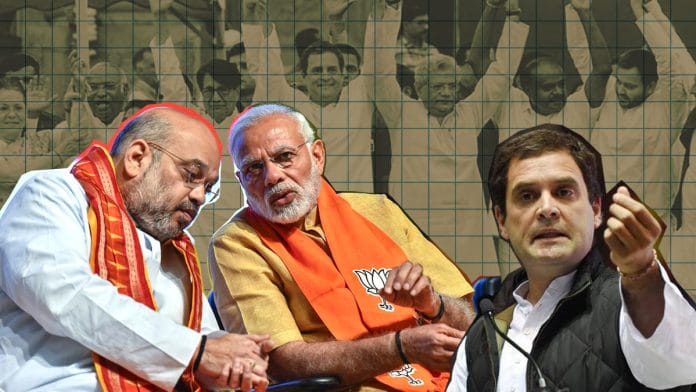BJP president Amit Shah urged party workers in poll-bound Rajasthan to ask people if they wanted Rahul Gandhi as prime minister and Mamata Banerjee as external affairs minister, and dismissed any threat from a mahagathbandhan.
ThePrint asks: What suits Narendra Modi and Amit Shah better – Rahul Gandhi or a faceless mahagathbandhan?
Voters rejected Indira, Rajiv and Vajpayee even when there weren’t clear alternatives
 Rasheed Kidwai
Rasheed Kidwai
Visiting Fellow, Observer Research Foundation
Be it a mahagathbandan or a Rahul Gandhi-led alliance, the electorate in 2019 will essentially be voting for or against the Narendra Modi regime. BJP chief Amit Shah’s attempts to frighten voters with Rahul as prime minister, Mamata Banerjee as foreign minister are futile attempts and, at best, part of a political rhetoric.
In 1977, 1989 and in 2004, voters rejected mighty Indira Gandhi, Rajiv Gandhi and Atal Bihari Vajpayee even when no clear alternative was in sight. This may hold true for 2019 as well.
The upcoming election will be fought in states, and across 543 Lok Sabha constituencies. Alliances like Samajwadi Party-Bahujan Samaj Party in Uttar Pradesh have a proven track record of checkmating a bullish BJP after the Babri Masjid demolition of 1992. The signs of TDP, CPM and Congress coming together in Telangana may be termed opportunistic but it is pragmatic.
The Modi-Amit Shah ‘jodi’ and their style of functioning provides an ideal setting for Mamata-Left, Congress-Chandrababu Naidu and other such ideologically opposite partners to come together.
Paradoxical as it may sound, Rahul is both an asset and a liability for 2019. Non-NDA regional parties are confident that the Congress chief will not stand for prestige (prime minister’s post) and pave the way for a non-NDA government just as he did in Karnataka.
I have often said that Rahul, much like Sonia, is not a power-wielder but a trustee of power. In theoretical terms, Rahul-led Congress fighting separately is good news for the BJP but a post-poll coming together of non-NDA parties is a certainty.
Many opposition stalwarts are nearing ‘sell-by’ date for PM-ship, won’t like Rahul as pick
 Sandip Ghose
Sandip Ghose
Marketing executive and commentator
To project Rahul Gandhi or a mahagathbandhan as a challenger in 2019 is not the dilemma Amit Shah or the BJP is dealing with. It is rather a conundrum for the opposition to grapple with.
Many of the opposition stalwarts are nearing their ‘sell-by’ date for PM-ship. For them, this is going to be a now-or-never election (perhaps, barring a young Turk like Akhilesh Yadav). Giving Rahul prominence could turn this into a never-ever situation for these veterans. How many will, therefore, support making Rahul the leading face of the opposition – unless the re-energised Congress election machinery is able to ramp up overwhelming momentum for their new president – is doubtful.
On the other hand, an ambiguous or amorphous situation suits Amit Shah and Modi. Keeping Rahul on the run, in his shoot and scoot game, by attacking his credibility and dynastic baggage will leave him with little time to stitch meaningful alliances. The DNA of the Congress isn’t programmed to play second fiddle even when they are on a weak wicket. Its large retinue of family courtiers, whose pomposity is usually inversely proportionate to their electoral base, does not help in making friends or influencing allies.
Statements like that of Mallikarjun Kharge, saying that Rahul will emerge as a “natural choice” for opposition PM, would not exactly be music to Mamata Banerjee and Mayawati’s ears.
So Shah and Modi will continue to train their guns at Rahul while working on the cracks within the opposition. How the no-confidence motion played out in Lok Sabha offered a sneak preview of that strategy.
It makes little difference to Modi-Shah whether opposition is Rahul Gandhi or grand alliance
 Sanjay Kumar
Sanjay Kumar
Director, Centre for the Study of Developing Studies
Various surveys suggest that Indians may be disenchanted with the overall work done by the BJP government. There is also a marginal decline in the personal popularity of Prime Minister Narendra Modi, but let’s be clear, Modi remains far more popular than any other leader.
This popularity of Modi among voters has made the task easier for both Modi and Amit Shah to mobilise votes for the BJP during various elections. It makes little difference to them whether the opposition is headed by Rahul Gandhi or if the mahagathbandhan is faceless.
In any of these situations, the Shah-Modi duo is placed comfortably to enjoy an advantage over the opposition since many of the regional parties do not command a national support base. The team would score much higher compared to any leader of the opposition party or the mahagathbandhan.
But on a comparative scale, the opposition headed by Rahul Gandhi might provide
them with a greater opportunity to attack the opposition. They can easily make
one leader their target, but if the mahagathbandan is faceless, the BJP
would have to fire their guns against too many leaders at the same time. An
aggressive onslaught on each and every leader of the opposition may not be
received well.
Some of the regional leaders may not be popular nationally, but they are as popular
as the Prime Minister in their respective states – Mamata Banerjee in West
Bengal, Naveen Patnaik in Odisha, Chandrababu Naidu in Andhra Pradesh, Lalu Yadav or Tejashwi Yadav in Bihar or even Arvind Kejriwal in Delhi.
Shah-Modi launching an attack on all these leaders may result in supporters of these leaders coming together with greater bonding among them.
Also read: Amit Shah is jetting off to Rajasthan to pacify ‘angry’ party workers
In our first-past-the-post system, it always helps to have a fractured opposition
 Rajat Roy
Rajat Roy
Member, Mahanirban Calcutta Research Group
In the upcoming 2019 general elections, Narendra Modi and Amit Shah will definitely prefer a Rahul Gandhi-led Congress to a mahagathbandhan of major opposition parties. Although, the history of various coalition governments at the Centre has remained poor, and the prospect of another short-lived coalition government might deter a large section of voters, the BJP is afraid to face the mahagathbandhan.
The last few by elections in Uttar Pradesh have shown that the BJP could be defeated in its stronghold if the major opposition parties (in this case Mayawati’s BSP and Akhilesh’s SP) come together. Also, the post-poll alliance of the JD(S) and the Congress in Karnataka killed the chance, if any, of the BJP clinging to that state.
The BJP is well aware of the fact that on two occasions the opposition parties fought the elections together (1977 and 1989), and the ruling party (the Congress) was ousted from power. Since in our parliamentary democracy the winner is the one who is ‘first past the post’, it always helps a party in power to face a fractured opposition. BJP leaders like Modi and Shah know that in absence of a mahagathbandhan, the Congress would not be able to stop the BJP juggernaut in a multi-corner contest. With that in mind, Shah is now trying to create confusion among the opposition by cynically drawing a scenario of a coalition government where Rahul Gandhi is the prime minister and Mamata, Mayawati hold various portfolios, knowing well that they all aspire for the prime ministerial chair.
One thing Modi-Shah can’t beat is high inflation & the risk is real
 Shivam Vij
Shivam Vij
Contributing Editor, The Print
Rahul Gandhi is Narendra Modi’s biggest asset. Rahul Gandhi even at his best is not a leader who can make a dent in Brand Modi. Others, who could perhaps do so, such as Nitish Kumar or Arvind Kejriwal left the national stage in 2017. Rahul, with his lack of achievements to boast about and poor communication skills, is Modi and Amit Shah’s best bet for 2019.
Writing recently in ThePrint, Shobhaa De said she’d prefer a “duffer” over a “demagogue” – Rahul over Modi. There can’t be a better example of how poor Rahul’s image is – even those who’d see him as PM over Modi call him “duffer”.
The proposed national unity of opposition parties is still in the proposal stage. There hasn’t been a serious meeting of this mahagathbandhan. It’s still a pipe dream. Its leaders seem more interested in vying for the prime minister’s post than actually putting up a united show.
Modi looks better than this non-gatbandhan, which does not have a united leader or a singular message. This non-starter is being used by the BJP to ask people: Do you really want an unstable coalition led by greedy satraps? Do you really want Mayawati or Mamata Banerjee or K.C.R. Rao as prime minister?
If the opposition has a face (Rahul Gandhi), it loses because the face is poor. If the opposition does not have a face, it loses because ‘there is no alternative’.
Even if the mahagatbandhan actually takes off, it may not be much of a challenge to Modi-Shah. All they have to say is: Modi wants to remove poverty, but they want to remove Modi.
There is one thing that Modi-Shah can’t beat: high inflation. With the rupee falling and fuel prices rising, the risk is real.
BJP knows a weak opposition face is more dangerous than rickety alliance
 Ruhi Tewari
Ruhi Tewari
Associate editor, The Print
If Prime Minister Narendra Modi is to be believed, no opposition can pose any challenge to the BJP. But that, of course, is more bluster than belief. Although there is little denying that both situations offer the Modi-Shah duo ample fodder for attack – if it is Rahul Gandhi, then the digs come easy, and if it is a faceless coalition, then enough questions can be raised about its sustainability and credibility – it is perhaps the latter that works better for the party.
The answer to this question can be found in history. In the 1977 Lok Sabha polls post-Emergency, the all-powerful Prime Minister Indira Gandhi lost the elections to a hurriedly forged Janata alliance. The coalition, however, could barely remain stable and elections were called again in 1980 when Indira Gandhi-led Congress stormed back to power.
Similarly, the period from 1989 to 1991 saw unstable coalitions at the helm until the P.V. Narasimha Rao government came to power in 1991. Yet again, wobbly coalitions led to volatile politics from 1996 to 1999. The BJP itself came to power twice during this period but could not prove its majority. It was, however, the eventual beneficiary in 1999 in the face of such instability.
There is enough historical evidence that the BJP can point to in its campaign to make its case against a precariously balanced alliance of a motley group of parties. The one thing the Indian electorate is wary of today is instability, and the decisive mandates in recent years are proof of that. On the other hand, the BJP saw what happened in 2004. With Sonia Gandhi as its face, who till then was also taken lightly and mocked at, the Congress dislodged the BJP from power since it fought as a cohesive force.
The party, thus, knows that even a weak, questionable opposition face is far more threatening than a rickety, faceless front.
By Fatima Khan, journalist at ThePrint. You can follow her on twitter @khanthefatima.






